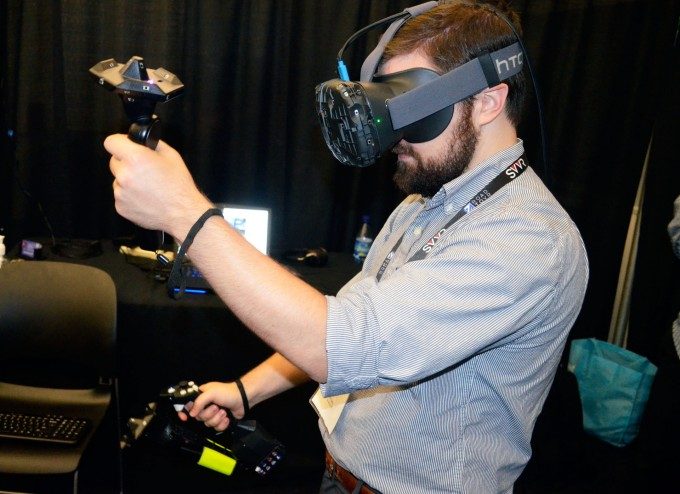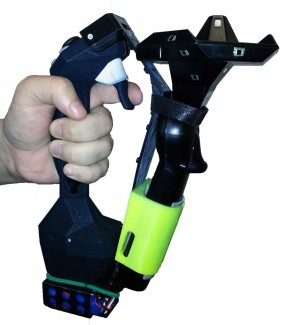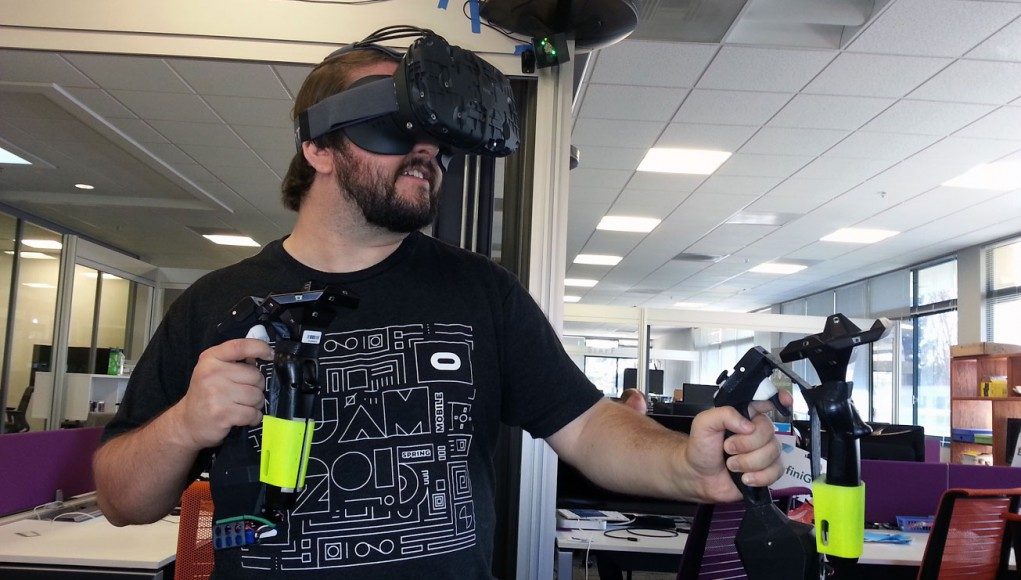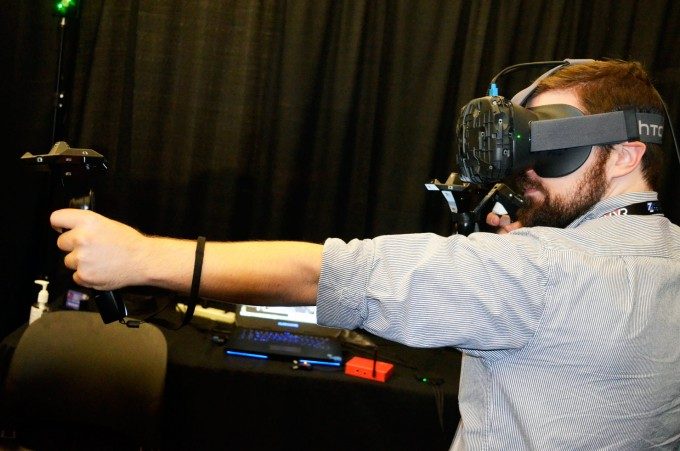Frank He caught up with Tactical Haptics at VRLA’s Winter Expo earlier in the year to get a personally much anticipated hands-on demo of their Reactive Grip technology and finds himself at first disappointed and then astounded at its potential.
Tactical Haptics (TH) was present at VRLA’s Winter Expo this year, demonstrating their skin-stretching Reactive Grip haptic feedback technology with a retrofitted HTC Vive SteamVR controller attachment. Ben Lang went hands-on with a similar system back at SVVR last year. However, for this show, TH had brought with them a new application, developed in-house to show off exactly what the system could do.
Having read and seen previous hands-on articles and videos featuring Road to VR‘s Ben Lang, I’d conjured an idea of what I expected to feel with Reactive Grip. However, with the older demos they showed me at least, I confess to feeling a little disappointed. I could certainly feel the direction of the feedback when wielding a flail or a gun for example, which was certainly valuable, but it didn’t quite feel like it was natural, physical, or a result of the forces that would have acted on your hand and body were they real. The plates moving under my hands still felt just like that – plates moving under my hands.

But Tactical Haptics then showed me a brand new experience, an in-house developed VR painting application, similar in style to Google’s Tilt Brush. It might have only been for a minute, but ‘drawing’ things in the air actually felt like I was drawing something on a physical surface, in the air. It felt like dragging a brush through a slightly thick medium of some sort. I forgot I had plates moving around in my controller’s handles, and the visual confirmation of my brush dragging paint around matched what I felt in my hands. It felt completely natural, and in my mind, the controller and the brush became one. It was absolutely amazing!
 After the demo, I discussed my experience with Michael Jones, Lead Software Engineer & 3d Artist at Tactical Haptics. “Most people tell us they like the haptic feedback while painting,” says Jones, “but [they] weren’t really sure as to why. Basically, I think it comes down to [what] you mentioned, that feeling of friction that we’re used to when [physically] drawing. If you’ve ever tried drawing on a Cell Phone or a smooth surface Wacom Tablet, it feels too smooth and hard to control, unlike drawing on paper which has some friction and texture.”
After the demo, I discussed my experience with Michael Jones, Lead Software Engineer & 3d Artist at Tactical Haptics. “Most people tell us they like the haptic feedback while painting,” says Jones, “but [they] weren’t really sure as to why. Basically, I think it comes down to [what] you mentioned, that feeling of friction that we’re used to when [physically] drawing. If you’ve ever tried drawing on a Cell Phone or a smooth surface Wacom Tablet, it feels too smooth and hard to control, unlike drawing on paper which has some friction and texture.”
For me, the key point is that Reactive Grip finally ‘clicked’ with me. I finally got what I will refer to as “haptic presence.” In the same way that HMDs are the VR for your sense of vision, Reactive Grip is the VR for your sense of touch. Of course it can’t do everything though, and it’s not perfect, but that’s alright. What the demo showed me was that this sort of presence is possible. It isn’t a dream any more. It’s well within reach – both convincing VR, and VR haptics.
I think an important lesson here, one that VR keeps teaching time and time again, is that if you you’re disappointed with a particular VR experience, you shouldn’t write anything off completely. Even with all the time I’ve now clocked up in VR, sometimes I get a demo that makes me feel uncomfortable or something, and I find myself thinking “Why did I even get into this? VR sucks and is clearly not the future!” Even though I know that’s not true, sometimes the experience can just make you feel that way, when you’re in the moment. But if a bad demo is the only experience you’ve had of the technology, then that feeling you get in the moment will be the feeling you have till the day you give it a chance again and, hopefully, get a good demo.
The more I think back to the minute of that ‘haptic presence’ I obtained, the more magical it seems, and the more fond I grow of the memory. It’s a tough call to make, because there were other truly amazing experiences I had at the show, but I’m inclined to call Tactical Haptics my favorite demo of VRLA’s Winter Expo. Now, with the first generation of virtual reality becoming a reality in the consumer space, I eagerly await the day that the same could be said for Tactical Haptics – hopefully alongside the next generation of VR.








